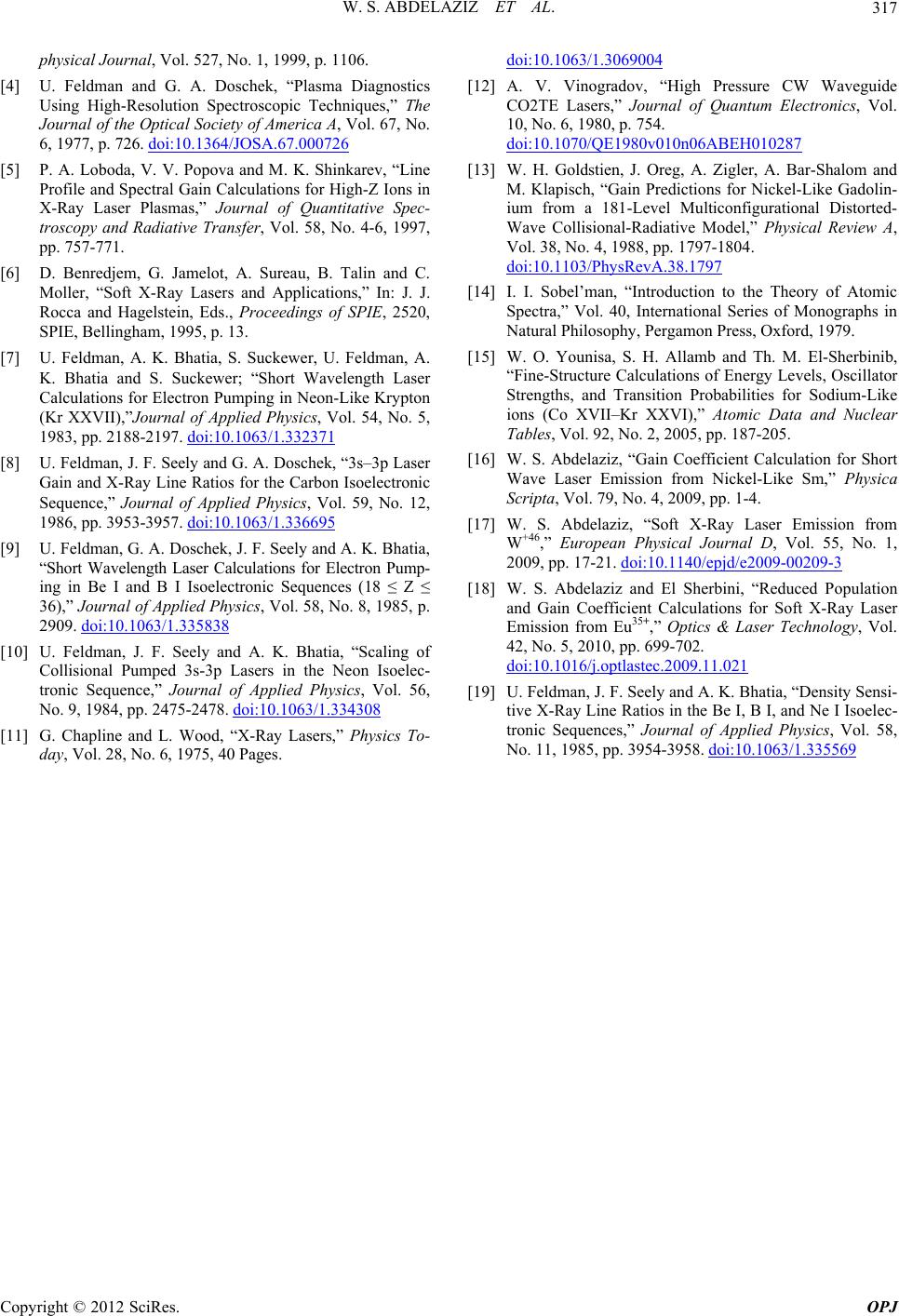
W. S. ABDELAZIZ ET AL.
Copyright © 2012 SciRes. OPJ
317
physical Journal, Vol. 527, No. 1, 1999, p. 1106.
[4] U. Feldman and G. A. Doschek, “Plasma Diagnostics
Using High-Resolution Spectroscopic Techniques,” The
Journal of the Optical Society of America A, Vol. 67, No.
6, 1977, p. 726. doi:10.1364/JOSA.67.000726
[5] P. A. Loboda, V. V. Popova and M. K. Shinkarev, “Line
Profile and Spectral Gain Calculations for High-Z Ions in
X-Ray Laser Plasmas,” Journal of Quantitative Spec-
troscopy and Radiative Transfer, Vol. 58, No. 4-6, 1997,
pp. 757-771.
[6] D. Benredjem, G. Jamelot, A. Sureau, B. Talin and C.
Moller, “Soft X-Ray Lasers and Applications,” In: J. J.
Rocca and Hagelstein, Eds., Proceedings of SPIE, 2520,
SPIE, Bellingham, 1995, p. 13.
[7] U. Feldman, A. K. Bhatia, S. Suckewer, U. Feldman, A.
K. Bhatia and S. Suckewer; “Short Wavelength Laser
Calculations for Electron Pumping in Neon-Like Krypton
(Kr XXVII),”Journal of Applied Physics, Vol. 54, No. 5,
1983, pp. 2188-2197. doi:10.1063/1.332371
[8] U. Feldman, J. F. Seely and G. A. Doschek, “3s–3p Laser
Gain and X-Ray Line Ratios for the Carbon Isoelectronic
Sequence,” Journal of Applied Physics, Vol. 59, No. 12,
1986, pp. 3953-3957. doi:10.1063/1.336695
[9] U. Feldman, G. A. Doschek, J. F. Seely and A. K. Bhatia,
“Short Wavelength Laser Calculations for Electron Pump-
ing in Be I and B I Isoelectronic Sequences (18 ≤ Z ≤
36),” Journal of Applied Physics, Vol. 58, No. 8, 1985, p.
2909. doi:10.1063/1.335838
[10] U. Feldman, J. F. Seely and A. K. Bhatia, “Scaling of
Collisional Pumped 3s-3p Lasers in the Neon Isoelec-
tronic Sequence,” Journal of Applied Physics, Vol. 56,
No. 9, 1984, pp. 2475-2478. doi:10.1063/1.334308
[11] G. Chapline and L. Wood, “X-Ray Lasers,” Physics To-
day, Vol. 28, No. 6, 1975, 40 Pages.
doi:10.1063/1.3069004
[12] A. V. Vinogradov, “High Pressure CW Waveguide
CO2TE Lasers,” Journal of Quantum Electronics, Vol.
10, No. 6, 1980, p. 754.
doi:10.1070/QE1980v010n06ABEH010287
[13] W. H. Goldstien, J. Oreg, A. Zigler, A. Bar-Shalom and
M. Klapisch, “Gain Predictions for Nickel-Like Gadolin-
ium from a 181-Level Multiconfigurational Distorted-
Wave Collisional-Radiative Model,” Physical Review A,
Vol. 38, No. 4, 1988, pp. 1797-1804.
doi:10.1103/PhysRevA.38.1797
[14] I. I. Sobel’man, “Introduction to the Theory of Atomic
Spectra,” Vol. 40, International Series of Monographs in
Natural Philosophy, Pergamon Press, Oxford, 1979.
[15] W. O. Younisa, S. H. Allamb and Th. M. El-Sherbinib,
“Fine-Structure Calculations of Energy Levels, Oscillator
Strengths, and Transition Probabilities for Sodium-Like
ions (Co XVII–Kr XXVI),” Atomic Data and Nuclear
Tables, Vol. 92, No. 2, 2005, pp. 187-205.
[16] W. S. Abdelaziz, “Gain Coefficient Calculation for Short
Wave Laser Emission from Nickel-Like Sm,” Physica
Scripta, Vol. 79, No. 4, 2009, pp. 1-4.
[17] W. S. Abdelaziz, “Soft X-Ray Laser Emission from
W+46,” European Physical Journal D, Vol. 55, No. 1,
2009, pp. 17-21. doi:10.1140/epjd/e2009-00209-3
[18] W. S. Abdelaziz and El Sherbini, “Reduced Population
and Gain Coefficient Calculations for Soft X-Ray Laser
Emission from Eu35+,” Optics & Laser Technology, Vol.
42, No. 5, 2010, pp. 699-702.
doi:10.1016/j.optlastec.2009.11.021
[19] U. Feldman, J. F. Seely and A. K. Bhatia, “Density Sensi-
tive X-Ray Line Ratios in the Be I, B I, and Ne I Isoelec-
tronic Sequences,” Journal of Applied Physics, Vol. 58,
No. 11, 1985, pp. 3954-3958. doi:10.1063/1.335569